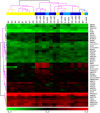Transcriptional alterations related to neuropathology and clinical manifestation of Alzheimer's disease
- PMID: 23144955
- PMCID: PMC3492444
- DOI: 10.1371/journal.pone.0048751
Transcriptional alterations related to neuropathology and clinical manifestation of Alzheimer's disease
Abstract
Alzheimer's disease (AD) is the most common cause of dementia in the human population, characterized by a spectrum of neuropathological abnormalities that results in memory impairment and loss of other cognitive processes as well as the presence of non-cognitive symptoms. Transcriptomic analyses provide an important approach to elucidating the pathogenesis of complex diseases like AD, helping to figure out both pre-clinical markers to identify susceptible patients and the early pathogenic mechanisms to serve as therapeutic targets. This study provides the gene expression profile of postmortem brain tissue from subjects with clinic-pathological AD (Braak IV, V, or V and CERAD B or C; and CDR ≥1), preclinical AD (Braak IV, V, or VI and CERAD B or C; and CDR = 0), and healthy older individuals (Braak ≤ II and CERAD 0 or A; and CDR = 0) in order to establish genes related to both AD neuropathology and clinical emergence of dementia. Based on differential gene expression, hierarchical clustering and network analysis, genes involved in energy metabolism, oxidative stress, DNA damage/repair, senescence, and transcriptional regulation were implicated with the neuropathology of AD; a transcriptional profile related to clinical manifestation of AD could not be detected with reliability using differential gene expression analysis, although genes involved in synaptic plasticity, and cell cycle seems to have a role revealed by gene classifier. In conclusion, the present data suggest gene expression profile changes secondary to the development of AD-related pathology and some genes that appear to be related to the clinical manifestation of dementia in subjects with significant AD pathology, making necessary further investigations to better understand these transcriptional findings on the pathogenesis and clinical emergence of AD.
Conflict of interest statement
Figures




Similar articles
-
Repair of oxidative DNA damage, cell-cycle regulation and neuronal death may influence the clinical manifestation of Alzheimer's disease.PLoS One. 2014 Jun 17;9(6):e99897. doi: 10.1371/journal.pone.0099897. eCollection 2014. PLoS One. 2014. PMID: 24936870 Free PMC article.
-
Integrative network analysis of nineteen brain regions identifies molecular signatures and networks underlying selective regional vulnerability to Alzheimer's disease.Genome Med. 2016 Nov 1;8(1):104. doi: 10.1186/s13073-016-0355-3. Genome Med. 2016. PMID: 27799057 Free PMC article.
-
Cell cycle checkpoint abnormalities during dementia: A plausible association with the loss of protection against oxidative stress in Alzheimer's disease [corrected].PLoS One. 2013 Jul 5;8(7):e68361. doi: 10.1371/journal.pone.0068361. Print 2013. PLoS One. 2013. PMID: 23861893 Free PMC article.
-
A third of community-dwelling elderly with intermediate and high level of Alzheimer's neuropathologic changes are not demented: A meta-analysis.Ageing Res Rev. 2020 Mar;58:101002. doi: 10.1016/j.arr.2019.101002. Epub 2019 Dec 30. Ageing Res Rev. 2020. PMID: 31899366
-
Use of cDNA microarray in the search for molecular markers involved in the onset of Alzheimer's disease dementia.J Neurosci Res. 2001 Sep 15;65(6):471-6. doi: 10.1002/jnr.1176. J Neurosci Res. 2001. PMID: 11550214 Review.
Cited by
-
Revelation of Pivotal Genes Pertinent to Alzheimer's Pathogenesis: A Methodical Evaluation of 32 GEO Datasets.J Mol Neurosci. 2022 Feb;72(2):303-322. doi: 10.1007/s12031-021-01919-2. Epub 2021 Oct 19. J Mol Neurosci. 2022. PMID: 34668150 Free PMC article.
-
Gene expression parallels synaptic excitability and plasticity changes in Alzheimer's disease.Front Cell Neurosci. 2015 Aug 25;9:318. doi: 10.3389/fncel.2015.00318. eCollection 2015. Front Cell Neurosci. 2015. PMID: 26379494 Free PMC article. Review.
-
Repair of oxidative DNA damage, cell-cycle regulation and neuronal death may influence the clinical manifestation of Alzheimer's disease.PLoS One. 2014 Jun 17;9(6):e99897. doi: 10.1371/journal.pone.0099897. eCollection 2014. PLoS One. 2014. PMID: 24936870 Free PMC article.
-
Neurodegenerative Disease Associated Pathways in the Brains of Triple Transgenic Alzheimer's Model Mice Are Reversed Following Two Weeks of Peripheral Administration of Fasudil.Int J Mol Sci. 2023 Jul 7;24(13):11219. doi: 10.3390/ijms241311219. Int J Mol Sci. 2023. PMID: 37446396 Free PMC article.
-
Progressive modulation of the human olfactory bulb transcriptome during Alzheimer´s disease evolution: novel insights into the olfactory signaling across proteinopathies.Oncotarget. 2017 May 23;8(41):69663-69679. doi: 10.18632/oncotarget.18193. eCollection 2017 Sep 19. Oncotarget. 2017. PMID: 29050232 Free PMC article.
References
-
- Blennow K, de Leon MJ, Zetterberg H (2006) Alzheimer’s disease. Lancet 368: 387–403. - PubMed
-
- Hardy J, Selkoe D (2002) The amyloid hypothesis of Alzheimer’s disease: progress and problems on the road to therapeutics. Science 297: 353–356. - PubMed
-
- Iqbal K, Alonso AC, Chen S, Chohan M, El-Akkad E, et al. (2005) Tau pathology in Alzheimer disease and other tauopathies. Biochim Biophys Acta 1739: 198–210. - PubMed
-
- McKhann G, Drachman D, Folstein M, Katzman R, Price D, et al. (1984) Clinical diagnosis of Alzheimer’s disease: report of the NINCDS-ADRDA Work Group under the auspices of Department of Health and Human Services Task Force on Alzheimer’s Disease. Neurology 34: 939–944. - PubMed
-
- Mirra S, Heyman A, McKeel D, Sumi S, Crain B, et al. (1991) The Consortium to Establish a Registry for Alzheimer’s Disease (CERAD). Part II. Standardization of the neuropathologic assessment of Alzheimer’s disease. Neurology 41: 479–486. - PubMed
Publication types
MeSH terms
LinkOut - more resources
Full Text Sources
Medical
Molecular Biology Databases

